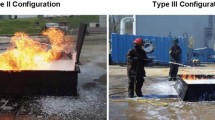Abstract
The proliferation of performance guidelines and specifications for firefighting foams has created divergent opinions on aviation fire protection standards. In this paper the technical basis for current U.S. and international aviation guidelines is presented. Issues associated with small- and large-scale fire tests are discussed. The correlation between fire test methods in theU.S. Military Specification for aqueous film-forming foam (AFFF) and current aviation fire protection guidelines is established. Trends and areas for further development are outlined.
Similar content being viewed by others
References
Fire Extinguishing Agent, Aqueous Film-Forming Foam (AFFF) Liquid Concentrate, for Fresh and Sea Water, Military Specification MIL-F-24385F, January 7, 1992.
Lindemann, T., “Aircraft Firefighting—In Three Minutes or Less,”Industrial Fire World Vol. 5, No. 1 (February/March 1990), pp. 16–24.
Geyer, G. B., “Effect of Ground Crash Fire on Aircraft Fuselage Integrity,”FAA Report RD-69-46, Atlantic City, N.J., December 1969.
Geyer, G. B., “Evaluation of Aircraft Ground Firefighting Agents and Techniques,”Technical Report AGFSRS 71-1 Tri-Service System Program Office for Aircraft Ground Fire Suppression and Rescue, Wright-Patterson AFB, Ohio, February 1972.
Eklund, T. I., and Sarkos, C. P., “The Thermal Impact of External Pool Fires on Aircraft Fuselages,”Journal of Fire and Flammability Vol. 11 (July 1980), p. 231.
NFPA 403,Aircraft Rescue and Firefighting Services at Airports National Fire Protection Association, Quincy, Mass., 1993.
Aircraft Fire and Rescue Facilities and Extinguishing Agents, Federal Aviation Administration Advisory Circular 150/5210-6C, U.S. Department of Transportation, Washington, D.C., January 28, 1985.
Airport Services Manual—Part 1, Rescue and Firefighting, International Civil Aviation Organization, Third Edition, Montreal, Canada, 1990, Chapters 2 and 8.
Report of the Rescue and Firefighting Panel, Second Meeting, Montreal, 5–16 June 1972, International Civil Aviation Organization (ICAO), Montreal, Canada, 1972.
Foam-Forming Liquids, Concentrated Fire Extinguishing, Mechanical, Federal Specification O-F-555b, March 11, 1964.
Fire Extinguishing Agent, Aqueous Film Forming Foam (AFFF) Liquid Concentrate Six Percent for Fresh and Sea Water, Military Specification MIL-F-24385, November 21, 1969.
Darwin, R. L., and Jablonski, E. J.,Full-Scale Fire Test Studies of Seawater Compatible ‘Light Water’ as Related to Shipboard Fire Protection Department of Navy Report, Washington, D.C., August 25, 1969.
Geyer, G. B., Neri, L. M., and Urban, C. H.,Comparative Evaluation of Firefighting Foam Agents, Federal Aviation Administration Report FAA-RD-79-61, Washington, D. C., August 1979.
Jablonski, E. J.,Comparative Nozzle Study for Applying Aqueous Filmforming Foam on Large-Scale Fires, U.S. Air Force Report CEEDO-TR-78-22, April 1978.
Department of the Navy,Qualified Products List of Products Qualified Under Military Specification, MIL-F-24385, Fire Extinguishing Agent, Aqueous Film Forming Foam (AFFF) Liquid Concentrate, for Fresh and Sea Water, QPL-24385-25, Naval Sea Systems Command, Washington, D.C., May 21, 1992.
Scheffey, J. L., Darwin, R. L., Leonard, J. T., Fulper, C. R., Ouellette, R. J., and Siegmann, C. W.,A Comparative Analysis of Film-Forming Fluoroprotein Foam (FFFP) and Aqueous Film-Forming Foam (AFFF) for Aircraft Rescue and Firefighting Services, Report 2108-A091-90 for the NFPA Aviation Committee, Hughes Associates, Inc., June 1990.
UL 162,Standard for Foam Equipment and Liquid Concentrates Underwriters Laboratories, Inc., Northbrook, Ill., Sixth Edition, March 7, 1989, and Seventh Edition, 1994.
Carey, W. M.,Report of the NFPA 403 Foam Test Criteria Task Force, presentation to the NFPA Technical Committee on Aircraft Rescue and firefighting, San Francisco, Calif., February 25, 1992.
“1993 Annual Meeting Technical Committee Report,”Report on Standard 403, Technical Committee on Aircraft Rescue and Firefighting, National Fire Protection Association, Quincy, Mass., 1993.
Scheffey, J. L., and Wright, J., “Analysis of Test Criteria for Specifying Foam Firefighting Agents for Aircraft Rescue and Firefighting,” FAA Technical Report, DOT/FAA/CT-94/04, Atlantic City, N.J., August 1994.
International Organization for Standardization, “Fire Extinguishing Media—Foam Concentrates, Part 1: Specification for Low Expansion Foam Characteristics for Top Application to Water Immiscible Liquids,” ISO Draft Standard, ISO/DIS 7203-1, 1992.
Carey, W. M., and Suchomel, M. R., “Testing of Firefighting Foam,”Underwriters Laboratories Report Number CG-M-1-81, Northbrook, Ill. November 1980.
Fiala, R., “Aircraft Post-Crash Firefighting/Rescue,” from AGARD Aircraft Fire Safety Lecture Series Number 123 (June 1982).
Hanauska, C. P., Scheffey, J. L., Roby, R. J., and Gottuck, D. T., “Improved Formulations of Firefighting Agents for Hydrocarbon Fuel Fires”,SBIR Phase I Final Report for the U.S. Air Force Hughes Associates, Inc., Columbia, Md., 1994.
Persson, H., “Fire Extinguishing Foams-Resistance Against Heat Radiation,”Brandforsk Project 609-903, SR Report 1992:54 Swedish National Testing and Research Institute, Sweden, 1992.
Persson, B., and Dahlberg, M., “A Simple Model for Predicting Foam Spread Over Liquids,”Fire Safety Science—Proceedings of the Fourth International Symposium, Ottawa, Canada, June 12–17, 1994 International Association for Fire Safety Science, Gaithersburg, Md., 1994.
Scheffey, J. L., “Foam Agents and AFFF Design Considerations,”The SFPE Handbook of Fire Protection Engineering, Second Edition, Quincy, Mass. 1995.
Darwin, R. L., Ottman, R. E., Norman, E. C., Gott, J. E., and Hanauska, C. P., “Foam and the Environment: A Delicate Balance,”Fire Journal Vol. 89, No. 3 (May/June 1995), pp. 67–73.
Author information
Authors and Affiliations
Rights and permissions
About this article
Cite this article
Scheffey, J.L., Darwin, R.L. & Leonard, J.T. Evaluating firefighting foams for aviation fire protection. Fire Technol 31, 224–243 (1995). https://doi.org/10.1007/BF01039193
Issue Date:
DOI: https://doi.org/10.1007/BF01039193




